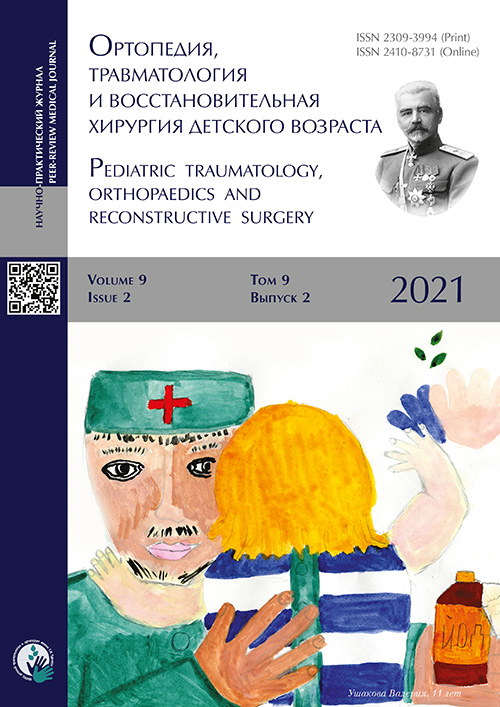Transposition of the great trochanter: A look at the problem
- Authors: Pozdnikin I.Y.1, Bortulev P.I.1, Barsukov D.B.1, Baskov V.E.1
-
Affiliations:
- H. Turner National Medical Research Center for Children’s Orthopedics and Trauma Surgery
- Issue: Vol 9, No 2 (2021)
- Pages: 195-202
- Section: Exchange of experience
- Submitted: 14.01.2021
- Accepted: 06.04.2021
- Published: 09.07.2021
- URL: https://journals.eco-vector.com/turner/article/view/58193
- DOI: https://doi.org/10.17816/PTORS58193
- ID: 58193
Cite item
Abstract
BACKGROUND: Multiplanar deformity of the proximal femur with a high position of the greater trochanter is one of the most common residual deformities of the hip joint. The Veau–Lamy transposition of the greater trochanter does not fully treat the mutual trauma of the components of the hip joint, as it only brings down the greater trochanter to provide tension for the gluteal muscles.
AIM: This study aimed to share the experience of performing transposition of the greater trochanter according to our proposed technique.
MATERIALS AND METHODS: The study included 15 patients (15 hip joints) aged 9–16 years with a high position of the greater trochanter of the femur, who underwent surgical treatment in the period from 2018 to 2019. In addition to the actual transposition of the greater trochanter, the intervention provided a modeling resection of the base (bed) of the greater trochanter and the formation of an offset of the femoral neck.
RESULTS: Patients were followed up for period of up to 30 months. All patients showed positive changes after surgical treatment with improvement of radiological and clinical parameters.
CONCLUSIONS: The proposed intervention allows restoration of the function of the gluteal muscles, improves the range of motion in the hip joint, and prevents and treats extra-articular impingement syndrome.
Full Text
About the authors
Ivan Y. Pozdnikin
H. Turner National Medical Research Center for Children’s Orthopedics and Trauma Surgery
Author for correspondence.
Email: pozdnikin@gmail.com
ORCID iD: 0000-0002-7026-1586
SPIN-code: 3744-8613
MD, PhD
Russian Federation, Saint PetersburgPavel I. Bortulev
H. Turner National Medical Research Center for Children’s Orthopedics and Trauma Surgery
Email: pavel.bortulev@yandex.ru
ORCID iD: 0000-0003-4931-2817
SPIN-code: 9903-6861
MD, PhD
Russian Federation, Saint PetersburgDmitry B. Barsukov
H. Turner National Medical Research Center for Children’s Orthopedics and Trauma Surgery
Email: dbbarsukov@gmail.com
ORCID iD: 0000-0002-9084-5634
SPIN-code: 2454-6548
MD, PhD
Russian Federation, Saint PetersburgVladimir E. Baskov
H. Turner National Medical Research Center for Children’s Orthopedics and Trauma Surgery
Email: drbaskov@mail.ru
ORCID iD: 0000-0003-0647-412X
SPIN-code: 1071-4570
MD, PhD
Russian Federation, Saint PetersburgReferences
- Sokolovskii OA, Koval’chuk OV, Sokolovskii AM, et al. Formirovanie deformatsii proksimal’nogo otdela bedra posle avaskulyarnogo nekroza golovki u detei. Novosti khirurgii. 2009;17(4):78–91. (In Russ.)
- Schneidmueller D, Carstens C, Thomsen M. Surgical treatment of overgrowth of the greater trochanter in children and adolescents. J Pediatr Orthop. 2006;26(4):486–490. doi: 10.1097/01.bpo.0000226281.01202.94
- Pozdnikin IJu, Baskov VE, Barsukov DB, et al. Gipertrofija bol’shogo vertela i vertel’no-tazovyj impindzhment-sindrom u detej (prichiny formirovanija, rentgenoanatomicheskaja harakteristika). Ortopedija, travmatologija i vosstanovitel’naja hirurgija detskogo vozrasta. 2019;7(3):15–24. (In Russ.). doi: 10.17816/PTORS7315-24
- Bortulyov PI, Vissarionov SV, Baskov VE, et al. Ocenka sostoyaniya pozvonochno-tazovyh sootnoshenij u detej s dvustoronnim vysokim stoyaniem bol’shogo vertela. Sovremennye problemy nauki i obrazovaniya. 2020;1:66. (In Russ.)
- Fridland MO. Ortopediya. Moscow: Medgiz, 1954. (In Russ.)
- Kelikian AS, Tachdjian MO, Askew MJ, Jasty M. Greater trochanteric advancement of the proximal femur: a clinical and biomechanical study. Hip. 1983:77–105.
- O’Rourke RJ, El Bitar Y. Femoroacetabular Impingement. In: StatPearls. Treasure Island (FL): StatPearls Publishing; 2020.
- de Sa D, Alradwan H, Cargnelli S, et al. Extra-articular hip impingement: a systematic review examining operative treatment of psoas, subspine, ischiofemoral, and greater trochanteric/pelvic impingement. Arthroscopy. 2014;30(8):1026–1041. doi: 10.1016/j.arthro.2014.02.042
- Mimura T, Shibata K, Tamura S, et al. Ischiofemoral impingement between the ischium and the posterior facet of the greater trochanter: A case report. J Orthop Sci. 2018;S0949-2658(18):30296–3. doi: 10.1016/j.jos.2018.08.029
- Kivlan BR, Martin RL, Martin HD. Ischiofemoral impingement: defining the lesser trochanter-ischial space. Knee Surg Sports Traumatol Arthrosc. 2017;25(1):72–76. doi: 10.1007/s00167-016-4036-y
- Singer AD, Subhawong TK, Jose J, et al. Ischiofemoral impingement syndrome: a meta-analysis. Skeletal Radiol. 2015;44(6):831–837. doi: 10.1007/s00256-015-2111-y
- Torriani M, Souto SC, Thomas BJ, et al. Ischiofemoral impingement syndrome: an entity with hip pain and abnormalities of the quadratus femoris muscle. Am J Roentgenol. 2009;193(1):186–190. doi: 10.2214/AJR.08.2090
- Patent RF No. 2734054 RF, MPK A61V 17/76/ 12.10.2020, Bjul. No. 29. Pozdnikin IJu, Barsukov DB, Bortuljov PI. Sposob hirurgicheskogo lechenija detej s vysokim polozheniem bol’shogo vertela. (In Russ.) [cited 2021 Apr 6]. Available from: https://patenton.ru/patent/RU2734054C1
- Stafford GH, Villar RN. Ischiofemoral impingement. J Bone Joint Surg Br. 2011;93(10):1300–1302. doi: 10.1302/0301-620X.93B10.26714
- Ganz R, Gill TJ, Gautier E, et al. Surgical dislocation of the adult hip a technique with full access to the femoral head and acetabulum without the risk of avascular necrosis. J Bone Joint Surg Br. 2001;83(8):1119–1124. doi: 10.1302/0301-620x.83b8.11964
- Gautier E, Ganz K, Krügel N, et al. Anatomy of the medial femoral circumflex artery and its surgical implications. J Bone Joint Surg Br. 2000;82(5):679–683. doi: 10.1302/0301-620x.82b5.10426
- Shin SJ, Kwak HS, Cho TJ, et al. Application of Ganz surgical hip dislocation approach in pediatric hip diseases. Clin Orthop Surg. 2009;1(3):132–137. doi: 10.4055/cios.2009.1.3.132
- Goldberg-Stein S, Friedman A, Gao Q, et al. Narrowing of ischiofemoral and quadratus femoris spaces in pediatric ischiofemoral impingement. Skeletal Radiol. 2018;47(11):1505–1510. doi: 10.1007/s00256-018-2962-0
Supplementary files











